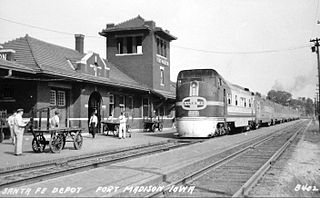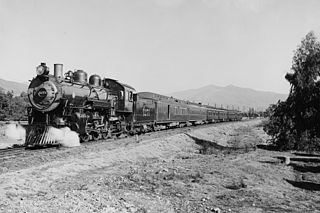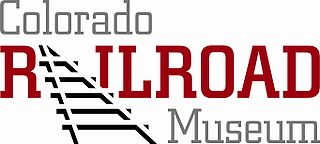Related Research Articles

The EMD FP45 is a cowl unit type of C-C diesel locomotive produced in the United States by General Motors Electro-Motive Division (EMD). It was produced beginning in 1967 at the request of the Atchison, Topeka and Santa Fe Railway, which did not want its prestigious Super Chief/El Capitan and other passenger trains pulled by freight style hood unit locomotives, which have external walkways.

The Atchison, Topeka and Santa Fe Railway, often referred to as the Santa Fe or AT&SF, was one of the largest Class 1 railroads in the United States.

The California State Railroad Museum is a museum in the California State Parks system that interprets the role of railroads in the West. It is located in Old Sacramento State Historic Park at 111 I Street, Sacramento, California.

The Super Chief was one of the named passenger trains and the flagship of the Atchison, Topeka and Santa Fe Railway. The then-modern streamliner was touted in its heyday as "The Train of the Stars" because it often carried celebrities between Chicago, Illinois, and Los Angeles, California.

Electro-Motive Corporation produced five 1800 hp B-B experimental passenger train-hauling diesel locomotives in 1935; two company-owned demonstrators, #511 and #512, the Baltimore and Ohio Railroad's #50, and two units for the Atchison, Topeka and Santa Fe Railway, Diesel Locomotive #1. The twin engine power unit layout and multiple unit control systems developed with the B-B locomotives were soon adopted for other locomotives such as the Burlington Route's Zephyr locomotives built by the Budd Company in 1936 and EMC's own EMD E-units introduced in 1937. The B-B locomotives worked as proof-of-concept demonstrators for diesel power with the service loads of full size trains, breaking out of its niche powering the smaller custom Streamliners.

The El Capitan was a streamlined passenger train operated by the Atchison, Topeka and Santa Fe Railway between Chicago, Illinois, and Los Angeles, California. It operated from 1938 to 1971; Amtrak retained the name until 1973. The El Capitan was the only all-coach or "chair car" to operate on the Santa Fe main line between Chicago and Los Angeles on the same fast schedule as the railroad's premier all-Pullman Super Chief. It was also the first train to receive the pioneering Hi-Level equipment with which it would become synonymous.

Atchison, Topeka and Santa Fe 3751 is a class "3751" 4-8-4 "Heavy Mountain" type steam locomotive built in May 1927 by the Baldwin Locomotive Works in Eddystone (Philadelphia), Pennsylvania for the Atchison, Topeka & Santa Fe Railway (ATSF). No. 3751 was the first 4-8-4 steam locomotive built for the Santa Fe and was referenced in documentation as type: "Heavy Mountain", "New Mountain", or "Mountain 4-wheel trailer". No. 3751 served in passenger duties until being retired in 1953.

The Grand Canyon Limited was one of the named passenger trains of the Atchison, Topeka and Santa Fe Railway. It was train Nos. 23 & 24 between Chicago, Illinois, and Los Angeles, California.

The Santa Fe de Luxe was the first extra-fare named passenger train on the Atchison, Topeka and Santa Fe Railway.

The Colorado Railroad Museum is a non-profit railroad museum. The museum is located on 15 acres (6.1 ha) at a point where Clear Creek flows between North and South Table Mountains in Golden, Colorado.

The Santa Fe CF7 is an EMD F-unit railroad locomotive that has had its streamlined carbody removed and replaced with a custom-made, "general purpose" body in order to adapt the unit for switching duty. All of the conversions were performed by the Atchison, Topeka & Santa Fe Railway's Cleburne, Texas, workshops between February 1970 and 1978. This was Santa Fe's most notable remanufacturing project, with 233 completed between 1970 - March 1978. The program was initiated in response to a system-wide need for more than 200 additional four-axle diesel road switchers to meet projected motive power demands on branch lines and secondary main lines.
The Valley Flyer was a short-lived named passenger train of the Atchison, Topeka and Santa Fe Railway. The all-heavyweight, "semi-streamlined" train ran between Bakersfield and Oakland, California during the 1939–1940 Golden Gate International Exposition on Treasure Island in San Francisco Bay. Motive power was two Baldwin-built 1300 class 4-6-2 "Pacific" locomotives refurbished and decorated for the train. It was the Santa Fe's first attempt at streamlining older steam power.

The California Southern Railroad was a subsidiary railroad of the Atchison, Topeka and Santa Fe Railway in Southern California. It was organized July 10, 1880, and chartered on October 23, 1880, to build a rail connection between what has become the city of Barstow and San Diego, California.

The Great Train Story is a 3,500-square-foot (330 m2) HO scale model railroad display located in the Transportation Zone of Chicago's Museum of Science and Industry. It explains the story of modern-day rail transportation in a 2,206-mile (3,550 km) journey from Seattle, Washington, through several plains states en route to Chicago, Illinois. The layout features 192 custom models of buildings and landmarks including the Willis Tower, Chicago Board of Trade Building, and Union Station in Chicago; and Seattle’s Space Needle, Experience Music Project and King Street Station. The landscape between the two cities includes several natural features such as the Cascade range, Rocky Mountains, waterfalls and forests. Man-made highlights include small towns, tunnels, truss arch and truss bridges, a lumber mill, farms, grain silos, a fruit packing house, a coal mine, and a steel mill.

The Museum of the American Railroad, formerly known as the Age of Steam Railroad Museum, is a railroad museum in Frisco, Texas. The museum has more than 70 pieces of steam, diesel, passenger, and freight railroad equipment sitting on 15 acres making it one of the largest historic rail collections in the US. Guests may walk through some of the equipment on guided tours.

The San Diego Model Railroad Museum is a model railroad exhibit in San Diego, California. At 27,000 sq. ft., it is the largest such indoor exhibit in North America, and one of the largest in the world. The museum is located on the lower level of the Casa de Balboa Building on the Prado in Balboa Park.

The Texas Transportation Museum (TTM) is a transportation museum located in San Antonio, Texas.

The Southern California Railway Museum, formerly known as the Orange Empire Railway Museum, is a railroad museum in Perris, California, United States. It was founded in 1956 at Griffith Park in Los Angeles before moving to the former Pinacate Station as the "Orange Empire Trolley Museum" in 1958. It was renamed "Orange Empire Railway Museum" in 1975 after merging with a museum then known as the California Southern Railroad Museum, and adopted its current name in 2019. The museum also operates a heritage railroad on the museum grounds.
References
- ↑ "The Radio Dealer Year Book, 1925-1926" (PDF).
- ↑ "Third National Radio Show" (PDF). The Talking Machine World. November 15, 1924. p. 168.
- ↑ "Did You Know? Message Received!: Greenwich Was Site of Early Breakthrough in Global Communication". Greenwich Historical Society. 2020-10-02. Retrieved 2023-12-08.
- 1 2 3 "MINTON CRONKITE, 79, SHORT-WAVE PIONEER". The New York Times. Retrieved 2023-12-08.
- ↑ "Calling Ardrossan: Radio feat marked 95 years on". The Scotsman. December 11, 2016.
- ↑ Social Register, Summer. Social Register Association. 1920.
- ↑ "About". New York Society of Model Engineers | Unlock Your Inner Engineer!. Retrieved 2023-12-08.
- ↑ "Membership List—March 31, 1930". The Railway and Locomotive Historical Society Bulletin (21): 1–4. 1930. ISSN 0033-8842. JSTOR 43519571.
- ↑ "Transport: Model Railroaders". Time. 1937-09-13. ISSN 0040-781X . Retrieved 2023-12-08.
- ↑ Jackson, Malik (2020-07-08). "The Only Constant Is Change: The rifts and connections that bind South Shore together". South Side Weekly. Retrieved 2023-12-08.
- ↑ "History". Museum of Science and Industry. Retrieved 2023-12-08.
- ↑ "New train exhibit a model of accuracy". Chicago Tribune. 2002-09-15. Retrieved 2023-12-08.
- ↑ Oliver, Smith Hempstone. "The First Quarter-Century of Steam Locomotives in North America / Remaining Relics and Operable Replicas with a Catalog of Locomotive Models in the U. S. National Museum". United States National Museum Bulletin. Retrieved 2023-12-08.